Essential Guide to Bathroom Tile Grouting and Sealing
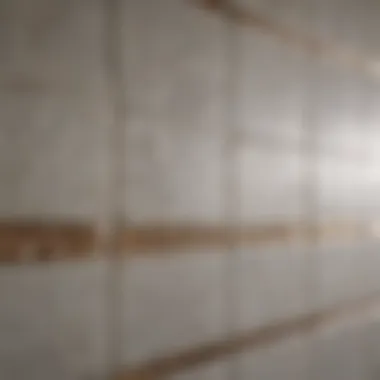
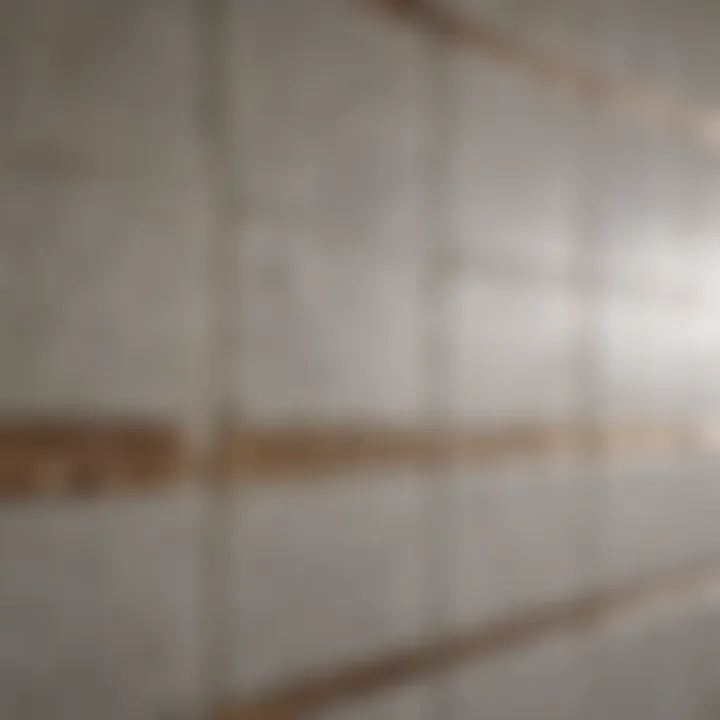
Intro
The bathroom is often a sanctuary within a home, a place that combines functionality with appealing aesthetics. Choosing the right tiles and understanding the processes of grouting and sealing can greatly enhance this space. Many homeowners embark on this journey, but might lack the detailed knowledge required for optimal execution. The goal of this guide is to fill that gap, providing valuable insights into materials, techniques, and maintenance strategies that will ensure the longevity and beauty of bathroom tiles.
Current Trends
Color Palettes
In recent years, homeowners have shown a preference for tranquil yet stylish color palettes. Soft blues, gentle grays, and earthy tones dominate many bathroom designs. These colors promote a calming atmosphere, and they blend well with natural light, enhancing the overall appearance of the space.
Popular Styles
Certain styles have become increasingly favorable, particularly minimalist and Scandinavian designs. These aesthetics emphasize clean lines, simplicity, and functionality. On the other hand, rustic and industrial styles also find their place, with exposed materials and vintage touches. This diversity allows homeowners to select a style that resonates with their personal taste.
Visual Ideas
Gallery of Styled Bathroom
Incorporating visual elements can significantly aid in the design process. For instance, a gallery showcasing various bathroom styles can provide inspiration. One might consider looking at sources like reddit.com or exploring social media platforms for ideas.
Before-and-After Transformations
Before-and-after images serve as a powerful motivator for those contemplating a renovation. Witnessing the change can help clarify the potential of tiles and effective sealing methods.
Understanding Tile Grouting
Tile grouting is a critical component in the installation and maintenance of tiled surfaces, especially in bathrooms. Understanding this process is essential for homeowners who desire both functionality and beauty in their spaces. Grout not only fills the gaps between tiles, but it also provides support, which enhances the overall stability of the tiled area.
Effective grouting can prevent water infiltration, mold growth, and damage to the underlying structures. Moreover, the aesthetics of grouted tiles can significantly influence the overall ambiance of a bathroom. Appropriate selection and application of grout create a seamless finish that highlights the beauty of the tiles.
Definition and Purpose
Grout is a fluid product used to fill the spaces between tiles. Its primary purpose is to secure the tiles in place, offering stability to the tiled surface. Grout also acts as a barrier against moisture, which is particularly important in bathrooms where humidity is a constant factor. By filling voids between tiles, grout helps to prevent dirt and debris accumulation while contributing to the overall clean appearance of the tile installation.
Different Types of Grout
When selecting grout, it is essential to understand the different types available.
Sanded Grout
Sanded grout contains sand particles, providing added strength and durability. This type is suitable for larger joints, typically over an eighth of an inch. Its primary characteristic is its ability to resist shrinking and cracking as it dries, making it a popular choice for floor tiles. The inclusion of sand also enhances its adhesion properties, creating a strong bond that supports tile longevity. However, sanded grout can be rough in texture, which may be less desirable for walls or delicate tiles.
Unsanded Grout
Unsanded grout is smoother and works well for tighter joints, usually less than an eighth of an inch. This type does not contain sand, which makes it easier to apply in intricate designs or smoother surfaces. It adheres well to vertical surfaces and is commonly used in bathroom wall tiles. The downside is that unsanded grout is generally less durable than its sanded counterpart, which could lead to issues with cracks over time if used inappropriately.
Epoxy Grout
Epoxy grout is a more advanced option made from a resin and hardener mix. This type of grout is exceptionally resistant to stains, chemicals, and water. Its unique feature is its non-porous nature, which significantly reduces the risk of mold and mildew growth. Epoxy grout is an excellent choice for high-traffic areas or wherever waterproofing is crucial. However, applying epoxy grout requires specific skills, and it can be more expensive than traditional grouts.
Choosing the Right Grout for Your Tiles
When selecting grout, consider factors such as tile type, joint width, and the area of installation. Choosing the right grout can affect not only the look but also the functionality and maintenance of the tiles. Each type of grout has its benefits and limitations, which should align with your specific project requirements. Always factor in the environment where tiles are installed. For example, in high-moisture areas like bathrooms, epoxy grout might be the best option due to its waterproof and stain-resistant properties.
The Role of Grout in Bathroom Tile Maintenance
Grout plays a crucial role in maintaining the integrity and appearance of tiled surfaces in bathrooms. It serves as a filler in the spaces between tiles, contributing both to the overall aesthetics and the functional structure of the tiled area. While tiles themselves do not usually absorb moisture, the grout can be affected by it. Therefore, understanding the role of grout is essential for anyone interested in maintaining their bathroom tiles effectively.
Aesthetic vs. Functional Aspects
Grout influences the visual appeal of a bathroom significantly. The color and texture of the grout can either enhance or detract from the overall design. A well-chosen grout color can unify or contrast the tile design, allowing for creative expression. Some homeowners prefer light-colored grout to give a spacious feel, while others lean towards dark grout for a modern and sophisticated touch. However, the aesthetic contribution is only one part of its role.
Functionally, grout acts as a sealant that protects the underlying structure from moisture, dirt, and mold. If the grout cracks or deteriorates, it compromises the entire tiled surface. This can lead to costly repairs or replacements. Thus, regular maintenance to keep grout in good condition is essential not just for beauty, but for protecting your investment.
Impact on Tile Longevity
The longevity of bathroom tiles is directly affected by the condition of the grout. Grout prevents water from seeping behind tiles and causing damage, such as rot or mold growth. When grout is not maintained, it can become discolored, cracked, or loose, leading to more significant problems over time.
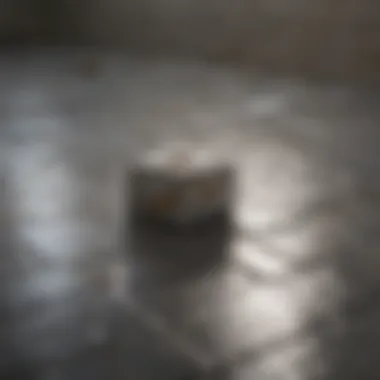
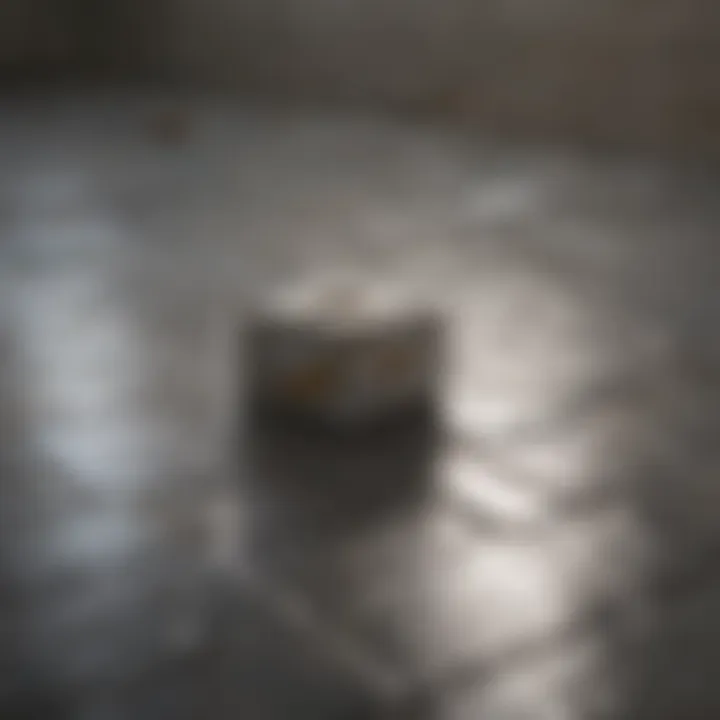
Regular inspection and maintenance can significantly increase tile lifespan. Grout sealing, for instance, should be done every one to five years depending on the type of grout and the level of wear and tear. Ignoring grout maintenance may lead to more severe issues, such as loosened tiles or dark stains from water damage.
In summary, the role of grout extends beyond mere aesthetics; it is foundational to the durability of tiled bathroom surfaces. Neglecting grout can lead to unforeseen complications, emphasizing the need for effective maintenance practices. Keeping an eye on the condition of grout can save considerable future expenses while also maintaining an appealing look in a bathroom.
Preparation for Grouting
Preparation serves as a critical foundation in the grouting process. Proper preparation minimizes risks and ensures a smooth application of grout. When done meticulously, it leads to enhanced results, both aesthetically and functionally.
Necessary Tools and Materials
Before beginning the grouting process, gathering the necessary tools and materials is essential. This preparation stage can significantly influence the overall effectiveness of the grout application. Here are the basic essentials you'll require:
- Grout: Choose the appropriate type based on the tiles and their installation location.
- Grout Float: This tool helps in spreading the grout evenly across the tiles.
- Sponge: A damp sponge is used for cleaning off excess grout from tile surfaces.
- Bucket: Use a bucket for mixing grout according to the manufacturer's instructions.
- Sealant: Have a suitable sealant ready for after the grout sets.
- Utility Knife: This is handy for cutting any excess or damaged grout lines.
Having these materials at hand allows for an efficient workflow, reducing interruptions once the process begins.
Surface Preparation Steps
The surface must be adequately prepared before applying grout. This reduces the chances of complications later on. Here are the key steps to take:
- Cleaning the Area: Ensure that the tile surfaces are clean and free from dust, dirt, or old adhesive. This helps the grout adhere properly.
- Inspecting Tiles: Verify that all tiles are firmly in place, with no loose tiles which could compromise the completed work.
- Repairing Damages: Fix any chipped or cracked tiles to create a uniform and sturdy foundation for grouting.
- Drying: Ensure the surface is completely dry before beginning. Moist surfaces can weaken the grout bond.
Following these steps will ensure that the grouting process is effective and provides reliable results, leading to a durable tiled surface and enhancing the overall appearance of your bathroom.
Grouting Process Explained
The grouting process is an essential part of tile installation that requires careful attention and skill. It serves not just an aesthetic function but also plays a crucial role in ensuring the durability and longevity of the tiled surface. Proper application of grout can prevent water damage, mold growth, and the weakening of tile adhesion, which can lead to costly repairs down the line. The following sections will discuss how to apply grout effectively and the subsequent cleanup required to maintain the quality of your tiled bathroom.
Applying the Grout
Before starting the application of grout, preparation is key. Ensure that the tile surfaces are free from dust, debris, and any residual adhesive. After mixing the grout according to the package instructions, use a rubber float to scoop some grout and press it diagonally into the joints between the tiles. This method ensures that the grout fills the spaces completely without leaving air gaps. It's important to work in small sections, as grout can start to set quickly.
When applying the grout, be mindful of the grout lines. Maintain consistent width and depth to achieve a professional look. After filling all joints, let the grout set for a few minutes, and then use a damp sponge to remove excess grout from the tile surfaces. Rinse the sponge frequently to ensure a clean finish.
Cleanup After Grouting
Cleanup after grouting is a critical phase that cannot be overlooked. Once the grout has dried to the touch, typically after about 30 minutes, it’s time to begin the cleaning process. Use a clean, damp sponge to wipe down the tile surfaces. This will help remove any grout haze that may have formed on the tile surface during application.
It's crucial not to allow the grout to fully cure on the tiles, as this can result in difficult-to-remove residues.
Once the surface is performing well, allow the grout to cure completely for at least 24 hours before applying any sealants or exposing the area to moisture. Proper cleaning will enhance the overall appearance of your tile work and prepare it for future maintenance.
In summary, proper application and cleanup of grout are fundamental to achieving a durable and aesthetically pleasing tiled surface. Skipping these steps can lead to issues that undermine the entire installation.
Understanding Tile Sealing
In understanding tile sealing, one must consider the critical role that sealants play in the overall maintenance and protection of tiled surfaces, especially in bathrooms. Sealing is essential not merely for aesthetic considerations but also for the preservation of the integrity and functionality of grout and tiles over time. Grout, unsealed, is susceptible to absorption of moisture, dirt, and stains. These properties can lead to mildew, mold, and deterioration. Effective sealing, therefore, helps create a barrier against these elements, enhancing the durability of both the grout and the tiles.
Purpose of Sealing
The primary purpose of sealing is the prevention of water penetration, which can weaken grout joints and lead to costly repairs. This protective layer significantly reduces the chances of damage from spills, steam, and humidity that are common in bathrooms. Additionally, sealing simplifies maintenance. A sealed surface will resist stains, making routine cleaning less labor-intensive. Therefore, proper sealing is an investment in both time and resources, aimed at maintaining the longevity of bathroom surfaces.
Types of Sealers Available
When it comes to sealer options for tile and grout, homeowners typically choose between two major categories: penetrating sealers and membrane-forming sealers. Each has its unique attributes, and understanding them is critical for making an informed choice.
Penetrating Sealers
Penetrating sealers work below the surface of the grout or tile. They soak into the material, creating a barrier that prevents water, oil, and other contaminants from infiltrating. The key characteristic of these sealers is their ability to preserve the natural appearance of tile and grout while providing robust protection. This type of sealer has gained popularity due to its flexibility and effectiveness in a moist environment, like bathrooms.
Advantages of Penetrating Sealers:
- Non-discoloring: They do not alter the color of the grout or tile, maintaining the original look.
- Breathable: Penetrating sealers allow moisture vapor to escape, reducing pressure that can lead to damage.
Disadvantages of Penetrating Sealers:
- Reapplication Required: Depending on usage and exposure, these sealers needs reapplication every few years.
- Initial Cost: They may have a higher upfront cost than surface sealers, but this can be justified by their longevity.


Membrane-forming Sealers
Membrane-forming sealers, in contrast, create a protective layer on the surface of the grout or tile. This layer is effective in blocking spills and stains immediately after application. The key characteristic of these sealers is their ability to provide a higher level of immediate protection, making them a choice for areas that experience heavy soiling or staining.
Advantages of Membrane-forming Sealers:
- Immediate Protection: Offers a quick shield against spills and stains.
- Less Frequent Application: These sealers usually have longer-lasting protection compared to penetrating types.
Disadvantages of Membrane-forming Sealers:
- Altered Appearance: They can change the aesthetic, giving tiles a shinier surface that may not suit all preferences.
- Moisture Trapping Risk: If the application is not done correctly, they may trap moisture beneath the surface, resulting in damage over time.
Proper sealing is a preventive measure to protect your investment in your bathroom's aesthetics and functionality.
When to Seal Grout
Sealing grout is an important aspect of maintaining bathroom tiles. Many homeowners overlook this step, thinking that grout is already waterproof or does not need additional treatment. However, sealing grout is essential for protecting it from moisture, stains, and mildew. Knowing when to seal is crucial to prolonging the life and appearance of your bathroom tiles.
Indicators of Sealant Needs
There are several signs that indicate when grout needs sealing. Paying attention to these signs can save you from costly repairs in the long run:
- Dull Appearance: If grout lines look cloudy or dull, they may lack proper sealing. A sealant enhances the color and texture of grout.
- Water Absorption: Conduct a simple water test. If a drop of water darkens the grout, it signals that sealing is necessary. This means that moisture is penetrating the grout, leading to potential mold growth and damage.
- Stains on Grout: Any discoloration or stains on the grout can indicate that the seal has worn off. Immediate sealing can help prevent further deterioration.
- Mold Growth: If you notice mold or mildew growth in the grout lines, it suggests a lack of protection against moisture. Proper sealing can act as a barrier against mold.
Frequency of Sealing
The frequency of sealing grout is influenced by various factors. Regular maintenance will help maintain the integrity of your grout:
- Type of Grout Used: Some grouts, like epoxy grout, offer more resistance to moisture and staining, necessitating less frequent sealing.
- Usage of the Bathroom: High-traffic bathrooms may require sealing more often due to wear and tear. It's advisable to inspect these areas regularly.
- Quality of Sealant: Higher quality sealants may last longer than lower quality ones. Invest in good products for better durability.
As a general rule, sealing should be done every 1 to 3 years, depending on the conditions mentioned above.
"Preventive care is much easier and cheaper than correcting problems afterward."
By keeping an eye on your grout's condition and understanding when to reseal it, you can add years to the life of your tiles. Regular inspections and timely sealing can help avoid severe damage, ensuring a clean and beautiful bathroom.”
Steps in Sealing Grout
Sealing grout is a crucial step in maintaining a tiled bathroom. It protects the grout from moisture and stains, which can lead to unsightly mildew or damage over time. This process not only enhances the appearance of your tiles but also extends their lifespan. Proper sealing contributes to a clean and hygienic environment, making it an important consideration for homeowners. Now, let’s cover the essential steps involved in sealing grout.
Preparation for Sealing
Before applying a sealant, careful preparation is key. First, ensure that the grout is fully cured. This means waiting at least 48 to 72 hours after grouting. If the grout is not cured, the sealant might trap moisture and lead to issues later.
Next, clean the surface thoroughly. Use a mixture of warm water and a mild detergent to wipe down the tiles and grout lines. Avoid harsh chemicals, as they may damage the grout or tile. After cleaning, rinse with clean water and allow everything to dry completely. A dry surface ensures the sealant adheres properly.
Additionally, protect surrounding areas by using painter’s tape. Apply it along the tile edges to prevent accidental spills on the tile, which can create an uneven look on the surface.
Applying the Sealant
With your preparations complete, it is time to apply the sealant. Choose a quality product suited for bathroom environments. For example, using a penetrating sealer can provide deep protection, while a membrane-forming sealer forms a protective layer on the surface.
To apply, use a brush or a roller, ensuring even coverage on the grout lines. Aim for an even application, avoiding puddles. Allow the sealant to penetrate for the time specified by the manufacturer, which is usually around 5 to 15 minutes. After this period, remove excess sealant from the surface of the tiles using a clean, dry cloth, focusing on grout lines.
Pay attention to corners and edges, as these areas often require more careful sealing to prevent moisture intrusion.
Post-Sealing Care
After sealing, allow the grout to cure for at least 24 hours. This waiting period is crucial for the sealant to bond effectively. During this time, avoid exposing the area to moisture or foot traffic. Once cured, maintaining the sealant is vital. Regular cleaning with a mild detergent will help maintain the protective layer. Avoid abrasive cleaners, as they may wear down the sealant.
Important: Reassess the condition of the sealant every six months, checking for signs of wear or damage. If you observe discoloration or a dull appearance, it may be time to reapply the sealant.
Maintaining Grout and Sealant
Maintaining grout and sealant in your bathroom is crucial for both aesthetic and functional reasons. Grout fills the gaps between tiles and creates a unified look, while sealant protects this grout from moisture, stains, and mold. Proper maintenance ensures that your tiled surfaces remain attractive and durable, ultimately extending the life of your bathroom installations.
Routine Cleaning Practices
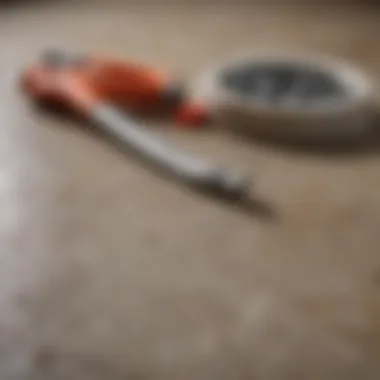

Regular cleaning is pivotal in maintaining both grout and sealant. Without consistent attention, grime and mold can accumulate, making the surfaces look unkempt. Here are some effective and straightforward cleaning practices:
- Use Gentle Cleaners: Avoid harsh chemicals that may degrade the sealant or grout. Opt for warm water mixed with mild soap or specialized tile cleaners.
- Avoid Abrasives: Scrubbing pads can scratch the surface and wear down sealants. Soft cloths or non-abrasive sponges work better.
- Spot Clean: Address spills and stains immediately. This prevents them from setting and becoming harder to clean later.
- Regular Mopping: For tiled floors, sweeping or vacuuming followed by mopping helps to remove dirt and debris without excessive scrubbing.
Implementing these routine practices fosters a clean and inviting bathroom environment.
Addressing Grout Damage
Over time, grout can become damaged due to various factors, including water infiltration, mold growth, or physical wear. Addressing these issues promptly is essential. Here’s how to manage grout damage effectively:
- Inspect Regularly: Make it a habit to check grout lines for cracks, discoloration, or wear. Early detection is key.
- Regrouting as Needed: If you discover damaged grout, consider regrouting. This involves removing the old grout and applying a new layer. It can enhance the appearance and restore protection against moisture.
- Use Grout Repair Kits: For small cracks, there are repair products available that can fill in gaps without the need for complete regrouting. These are especially useful for quick fixes.
- Seal After Repairs: Always seal newly applied grout to guard against future damage. Ensure the surface is completely dry before sealing to achieve the best results.
Proper maintenance of grout and sealant can save considerable costs in the long run by preventing extensive damage or the need for complete tile replacements.
Incorporating these practices into your cleaning routine enhances the longevity of your bathroom tile and keeps it looking fresh. Remember, consistent maintenance is far easier than addressing severe problems later.
Common Mistakes to Avoid
In the realm of bathroom tile grouting and sealing, avoiding common mistakes can greatly enhance the results of your efforts. Mistakes not only impact the functionality of the tiles but can lead to aesthetic disappointments as well. This section will discuss fundamental errors, their repercussions, and how to avert them.
Choosing the Wrong Materials
Selecting the appropriate materials for grouting and sealing is crucial. Many individuals may feel overwhelmed by the variety available. Often, they opt for products without considering their specific requirements.
Using sanded grout on fine tile can result in scratches, while unsanded grout may not fill larger joints effectively. Epoxy grout, although more expensive, offers superior resistance to stains and moisture. Thus, understanding the material properties is essential to achieve a long-lasting effect.
It's important to consider the bathroom environment as well. For instance, if you have a shower area prone to water exposure, using a moisture-resistant sealant will be more beneficial than a standard one. Always check instructions and product recommended usage to avert this pitfall.
Neglecting Surface Preparation
Surface preparation sets the stage for successful tile grouting and sealing. Skipping this step can lead to various issues such as poor adhesion and uneven surfaces. This mistake is more common than you might think.
Before applying grout, ensure the tiles are clean and free of debris. Even small particles can disrupt the grout's bond. Similarly, any residual moisture can compromise the sealing process. Use a vacuum or a damp cloth to ensure surfaces are adequately prepped.
"Proper surface preparation is critical for achieving the desired results in tiling projects. Irregularities can lead to significant long-term issues."
Many people underestimate this step. They may believe that as long as the tiles are visible, they are ready for grouting. However, effective preparation is necessary.
Improper Application Techniques
Application techniques can make or break the effectiveness of grout and sealant. A common issue is the uneven application of grout, which can result in unsightly lines and gaps. Additionally, not allowing the proper curing time before using the surface can lead to premature wear and damage.
When applying grout, it’s vital to follow a consistent process. Use a float to spread the grout evenly over the joints. After grouting, wipe away excess material with a damp sponge. This helps in achieving a clean finish and minimizes mess.
Moreover, with sealing, applying too thick a layer can trap moisture underneath, leading to mold growth. It is better to apply several thin coats than one thick one.
In summary, being aware of these common errors and taking measures to avoid them will lead to an improved outcome in bathroom tile projects. Not only will your tiles look better, but they will also function more effectively, yielding long-term satisfaction.
Epilogue
In the realm of bathroom tile care, the conclusion serves as a pivotal reflection on the essential practices discussed throughout this guide. It encapsulates the importance of both grouting and sealing, emphasizing how these processes contribute to the durability and aesthetic appeal of tiled surfaces. By understanding the nuances involved in tile maintenance, homeowners can preserve their investments and maintain the beauty of their bathrooms for years to come.
One of the primary considerations is the selection of the appropriate materials. Choosing the right grout and sealer not only enhances the look of your tiles but also provides protection against moisture and stains. Further, regular maintenance practices can prevent issues such as mold and discoloration, which are common in bathroom environments.
These essential steps lead to long-term benefits. For example, properly sealed grout can resist water and oils, reducing the risk of damage. A well-maintained tile surface is not just visually appealing; it also ensures safety, as a clean and intact surface minimizes the risk of slips and falls.
"Investing time in proper care for tile can lead to significant savings on repairs and replacements down the road."
Ultimately, the conclusion of this guide acts as a call to action. It encourages homeowners to implement the best practices laid out, from preparation to maintenance, ensuring their bathrooms remain both functional and elegant. By prioritizing these practices, one will enhance their overall living environment.
Recap of Best Practices
To summarize the essential practices for maintaining bathroom tile, consider the following key points:
- Selection of Grout and Sealant: Always choose materials that are suitable for the specific type of tile and the bathroom conditions.
- Application Techniques: Follow the correct steps for grouting and sealing, ensuring they are applied evenly and with the appropriate tools.
- Routine Maintenance: Regularly clean tiles and inspect the grout for damage, addressing any issues promptly.
- Frequency of Sealing: Understand when to reseal grout, generally every one to two years, to maintain effectiveness.
These steps will help in achieving a clean, safe, and attractive bathroom.
Final Thoughts on Maintaining Your Bathroom Tile
Maintaining your bathroom tile is not merely an aesthetic consideration; it encompasses functionality, safety, and longevity. As bathrooms are frequently exposed to moisture, they require special attention to prevent damage.
Homeowners should view bathroom maintenance as an ongoing process. From selecting the right materials to implementing routine upkeep, every action contributes to the overall performance of your bathroom tiles. Regular inspections and maintenance can save time and money in the long term, ensuring that your investment in your home is protected.
Moreover, with the right knowledge and tools, any homeowner can take charge of their bathroom care. Engaging in this upkeep enables a space that is not only more beautiful but also healthier for residents.



